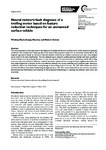Neural network fault diagnosis of a trolling motor based on feature reduction techniques for an unmanned surface vehicle
| dc.contributor.author | Abed, W | |
| dc.contributor.author | sharma, sanjay | |
| dc.contributor.author | Sutton, R | |
| dc.date.accessioned | 2015-10-15T10:56:44Z | |
| dc.date.available | 2015-10-15T10:56:44Z | |
| dc.date.issued | 2015-09 | |
| dc.identifier.issn | 0959-6518 | |
| dc.identifier.issn | 2041-3041 | |
| dc.identifier.uri | http://hdl.handle.net/10026.1/3637 | |
| dc.description.abstract |
<jats:p> This article presents a novel approach to the diagnosis of unbalanced faults in a trolling motor under stationary operating conditions. The trolling motor being typically of that used as the propulsion system for an unmanned surface vehicle, the diagnosis approach is based on the use of discrete wavelet transforms as a feature extraction tool and a time-delayed neural network for fault classification. The time-delayed neural network classifies between healthy and faulty conditions of the trolling motor by analysing the stator current and vibration. To overcome feature redundancy, which affects diagnosis accuracy, several feature reduction methods have been tested, and the orthogonal fuzzy neighbourhood discriminant analysis approach is found to be the most effective method. Four faulty conditions were analysed under laboratory conditions, where one of the blades causing damage to the trolling motor is cut into 10%, 25%, half and then into full to simulate the effects of propeller blades being damaged partly or fully. The results obtained from the real-time simulation demonstrate the effectiveness and reliability of the proposed methodology in classifying the different faults faster and accurately. </jats:p> | |
| dc.format.extent | 738-750 | |
| dc.language | en | |
| dc.language.iso | en | |
| dc.publisher | SAGE Publications | |
| dc.subject | Feature extraction | |
| dc.subject | feature reduction | |
| dc.subject | time-delayed neural network | |
| dc.title | Neural network fault diagnosis of a trolling motor based on feature reduction techniques for an unmanned surface vehicle | |
| dc.type | journal-article | |
| dc.type | Journal Article | |
| plymouth.author-url | https://www.webofscience.com/api/gateway?GWVersion=2&SrcApp=PARTNER_APP&SrcAuth=LinksAMR&KeyUT=WOS:000360410100006&DestLinkType=FullRecord&DestApp=ALL_WOS&UsrCustomerID=11bb513d99f797142bcfeffcc58ea008 | |
| plymouth.issue | 8 | |
| plymouth.volume | 229 | |
| plymouth.publication-status | Published | |
| plymouth.journal | Proceedings of the Institution of Mechanical Engineers, Part I: Journal of Systems and Control Engineering | |
| dc.identifier.doi | 10.1177/0959651815581095 | |
| plymouth.organisational-group | /Plymouth | |
| plymouth.organisational-group | /Plymouth/Faculty of Science and Engineering | |
| plymouth.organisational-group | /Plymouth/Faculty of Science and Engineering/School of Engineering, Computing and Mathematics | |
| plymouth.organisational-group | /Plymouth/REF 2021 Researchers by UoA | |
| plymouth.organisational-group | /Plymouth/REF 2021 Researchers by UoA/UoA12 Engineering | |
| plymouth.organisational-group | /Plymouth/Research Groups | |
| plymouth.organisational-group | /Plymouth/Research Groups/Marine Institute | |
| plymouth.organisational-group | /Plymouth/Users by role | |
| plymouth.organisational-group | /Plymouth/Users by role/Academics | |
| dc.identifier.eissn | 2041-3041 | |
| dc.rights.embargoperiod | Not known | |
| rioxxterms.versionofrecord | 10.1177/0959651815581095 | |
| rioxxterms.licenseref.uri | http://www.rioxx.net/licenses/all-rights-reserved | |
| rioxxterms.type | Journal Article/Review |


